Subcutaneous acne is a very unpleasant and painful type of acne. They appear when the sebaceous glands are blocked by sebaceous plugs. In the process, pus accumulates under the skin. A red bump appears on the surface, which is very painful and itches unbearably.
Subcutaneous acne appeared on the face: the main reasons
Often subcutaneous acne is a “disease of dirty hands.” A deep infection will manifest itself as subcutaneous inflammation, which will quickly spread to large surfaces;
Disruption of the endocrine system;
Internal health problems;
White subcutaneous pimples appeared on the face
If subcutaneous white pimples appear on the face, this indicates that the inflammation zone is as close as possible to the outer integument. This type of pimple can be easily treated using the same methods needed to treat regular acne.
Here you will need external agents with an antibiotic: “Zinerit”, “Dalacin”, spot application of tetracycline ointment or “Levomekol” ointment. At night, Vishnevsky ointment is applied to the subcutaneous pimple. It will help relieve inflammation and “push” the pimple to the surface of the skin. When a subcutaneous pimple “ripens”, it stops hurting and can be treated locally.
Subcutaneous acne appears on the face and itches
If subcutaneous acne itches, there are 2 scenarios:
The pimple heals, inflammation decreases, tissue regeneration occurs and itching occurs;
Inflammation affects the deeper layers of the skin, and the pimple begins to hurt and itch.
In the first option, it is enough to wipe the pimples with calendula tincture and apply Zenerite.
The second case requires consultation with a dermatologist. In addition to severe inflammation, such itching can be caused by demodicosis. Tests for skin mites are required.
Subcutaneous pimples appeared on the face and did not go away
If the usual remedies for acne are powerless, you will have to go to the doctor. Most likely, you will need a course of antibiotics to relieve inflammation. You will have to take a biochemical blood test, which will confirm the presence of internal inflammation. Until the cause of acne is treated, it will appear more and more often.
Subcutaneous acne appears on the face: who to contact?
The first thing you need to do is go to a dermatologist. The doctor will find out the causes of acne and prescribe the necessary therapy and refer you to other specialists (physiotherapist, cosmetologist).
When a subcutaneous pimple is “ripe”, you cannot squeeze it yourself! You need to go to a dermatologist. With the slightest mistake, you can get subcutaneous acne all over your body.
After opening a subcutaneous pimple, you should not go outside without smearing it with salicylic alcohol. The inflammation can easily return.
If suddenly a subcutaneous pimple was injured (torn off, squeezed out), an abscess may begin, affecting healthy skin. It is necessary to immediately cover the wound with a bactericidal adhesive plaster, having previously treated it with 3% hydrogen peroxide or any alcohol-containing liquid. If there is severe redness and pain, see a dermatologist.
How to treat subcutaneous acne
Subcutaneous acne can leave behind unsightly pits. Treatment requires ozone therapy. It will relieve inflammation. A single injection will help the subcutaneous pimple “mature” in a few hours. The shorter the period of “ripening” of a pimple, the fewer marks remain on the skin;
Darsonvalization. The method is used in hospitals and salons. You can purchase darsonval for home use. In a course of 10–15 procedures, all subcutaneous and ordinary acne will mature. Darsonval perfectly relieves even severe inflammation, redness and itching;
All anti-inflammatory herbs help: chamomile, propolis, calendula, sage, eucalyptus. Every day you need to wash your face with a herbal decoction; you should not wash your face with tap water;
Be sure to use "Zinerit". Even when the acne has matured, opened up and healed. The drug will prevent re-infection and help completely cure inflammation;
When a pimple appears. As soon as it becomes noticeable, it can be cauterized with iodine. The inflammation may go away and not spread further;
Wash with tar soap, apply birch tar to the subcutaneous pimple;
Wipe subcutaneous acne with tea tree oil.
The main rule when subcutaneous acne appears on the face is constant monitoring of the state of the body. If their appearance is accompanied by chills, pain, malaise, if pimples appear all over the body, consult a doctor immediately! You can deal with isolated subcutaneous pimples on your own.
Amina Pirmanova / article author
Inflamed areas of the skin - acne - appear when pores become clogged, sebum mixes with dirt, bacteria multiply, pus and inflammation appear. The appearance of itchy pimples on the body may indicate the presence of gastrointestinal diseases, hormonal imbalance, allergic reactions, or infections.
Prickly heat
Due to increased sweating and slow evaporation of moisture from the surface of the skin, an irritation called prickly heat may occur. Most often, infants are susceptible to it, because... their skin has a number of features compared to adults - it is softer, thinner, contains more moisture and capillaries.
The main reason for the appearance of heat rash in adulthood is increased sweating (hyperhidrosis), which is provoked by:
- infectious diseases and fever;
- excess weight;
- hormonal imbalances in women and men;
- diseases of the cardiovascular system;
- tight clothes;
- active sports and physical activity.
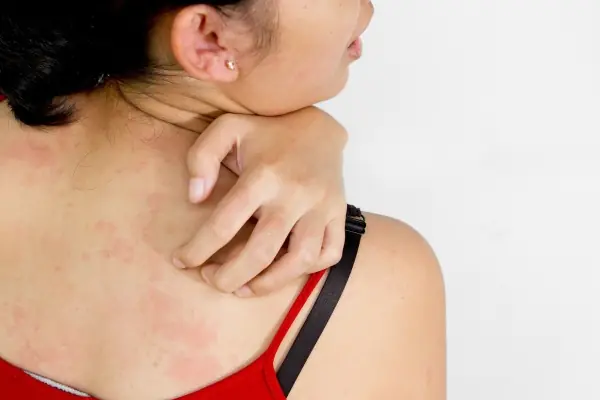
The initial signs of irritation are a feeling of itching and redness, which then turns into small bubbles with transparent contents. Pimples can be located in groups or separately. Locations in adults are closed areas of the skin:
- armpits;
- inguinal-scrotal folds;
- place at the bottom of the mammary glands;
- Hands.
Irritation manifests itself in different ways. Types of rash are distinguished by the nature of the rash and the speed of its spread; they imply different methods of healing.
- Miliaria crystalline- the safest, usually occurs due to heat. Many red blisters appear on the body, which go away on their own after the irritating factor is removed.
- Red – more serious. This heat rash appears as a blistering rash on red, inflamed skin. They become a chronic disease if left untreated. In this case, drying substances (talc) and wound healing ointments (based on dexpanthenol) are used.
- Papular miliaria It appears as red and transparent nodules surrounded by an inflammatory circle. Due to the presence of bacterial flora, they can combine into a single whole and form weeping lesions and suppuration. This type of prickly heat is treated with talcum powder, bactericidal and anti-inflammatory agents (chamomile decoction, chlorhexidine, bepanthen).
- Apocrine inflammation associated with the work of apocrine glands located in the armpits, perineum, and around the areola of the nipple. When the glands are disrupted, a rash appears. Treatment is carried out with daily hygiene and moisturizing baby creams.
Allergy
Allergic reactions are common causes of acne on the body. The immune system reacts to some allergen, and a large amount of the hormone histamine is released into the blood vessels. Redness, nodules, and spots form on the skin, which increase in size, spread throughout the body and itch. If left untreated, there is a risk of infection. The swollen blisters burst and ulcers appear on the body.
Within a few minutes after contact with an allergen irritant, a rash may appear. Common places for allergies to appear on the body:
- skin folds;
- stomach;
- shins;
- neck.
Treatment is possible using traditional medicine methods or the use of antihistamines prescribed by an allergist. Some medications can be added to homemade acne masks, for example, Enterosgel and Polysorb sorbents.
Atopic dermatitis
One of the manifestations of allergies is atopic dermatitis (from the Greek “atopy” - foreign), popularly known as diathesis. Approximately 10% of its occurrences are caused by food irritants. Other predisposing factors to the appearance of dermatitis, in addition to allergies, include: genetic predisposition to the production of immunoglobulin E, exposure to chemicals, stress.
Allergic dermatitis occurs in both children and adults, and is divided into three stages:
- infant (up to 2 years);
- children's (from 2 to 13);
- teenage and adult (from 13 years old).
Characteristic signs of dermatitis in infancy: the appearance of weeping irritations on the folds, face, body, dry skin, and the formation of crusts. Later, the location shifts to the elbow and popliteal fossae, neck, hands and soles. Children develop fissures, papules, and plaques. In adulthood, dermatitis affects the natural folds of the skin. The symptoms are the same: scratching, small pimples, plaques.
The disease is aggravated by nervous stress, profuse sweating, high temperature and humidity. If dirt gets into the wounds, they fester. Any treatment, in addition to eliminating the root cause, involves getting rid of itching.
The following drugs for dermatitis are used:
- antihistamines (“Suprastin”, “Zodak”, etc.);
- anti-itch desensitizers (calcium gluconate);
- medications to stabilize the nervous system (valerian, motherwort, etc.);
- sorbents, probiotics and eubiotics to normalize digestion;
- physiotherapy methods (if the disease has worsened);
- folk remedies.
Dermatosis
Inflammation of the skin, in which different parts of the body are affected and watery pimples are formed, is called dermatosis (from the Greek “skin”). This is the collective name for diseases that manifest themselves in changes in the skin. There are viral, fungal, parasitic and pustular dermatosis.
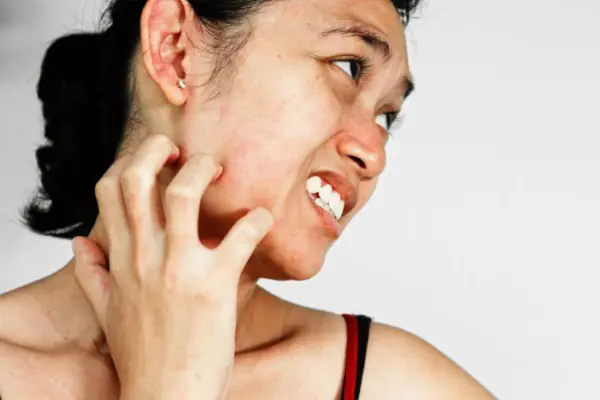
The pathology has no age restrictions; it occurs when internal organs are damaged or in the presence of external irritants. This could be mechanical damage, cuts, the influence of plant poisons, stress, metabolic problems, etc. In addition, the causes of dermatosis are:
- disruptions in the functioning of the endocrine system;
- disruption of internal organs (sinusitis, caries, etc.);
- neurological abnormalities;
- internal inflammatory processes;
Symptoms of the development of pathology vary depending on age:
- in infancy it is itching on the arms, legs and face;
- in childhood – allergies to various substances;
- adolescents experience acne and dermatitis, the causative agent of which is yeast-like fungi;
- in old age, the skin atrophies and warts appear.
Based on the clinical picture of dermatosis, the necessary treatment is prescribed: medications and diet are prescribed. Even if the pathology is chronic (for example, psoriasis), external manifestations can be cured.
Lichen
As a result of a viral infection of the skin, a disease such as lichen develops. A smooth rash appears in the form of small nodules and spots that itch. Pathology affects any part of the body. Ringworm is a contagious disease, which, however, does not pose a threat to health in the absence of proper treatment.
There are many types of lichen. The most common:
- red flat, the only element of which is a papule that has arisen on the skin;
- pink lichen of Zhiber, manifested in itchy spots all over the body;
- pityriasis or multi-colored, the spots of which are pink and brown;
- white, making the skin lighter;
- shingles - the itching is not severe, but bubbles with transparent contents appear.
Advanced forms of lichen are more difficult to cure, so measures must be taken at the initial stage. At home, lichen can be cured by constantly cauterizing it with iodine or Ketoconazole ointment.
Psoriasis
One type of lichen - scaly - is called psoriasis. This skin disease is characterized by severe itching and the appearance of white, scaly spots on the body. They merge to form plaques. The progressive stage of the disease causes general malaise: fever, weakness. Itching brings the greatest discomfort.
If psoriasis is treated in a timely manner, preventing the development of a chronic form and the appearance of other concomitant pathologies, it proceeds without complications and is not particularly disturbing. External manifestations can also be eliminated.
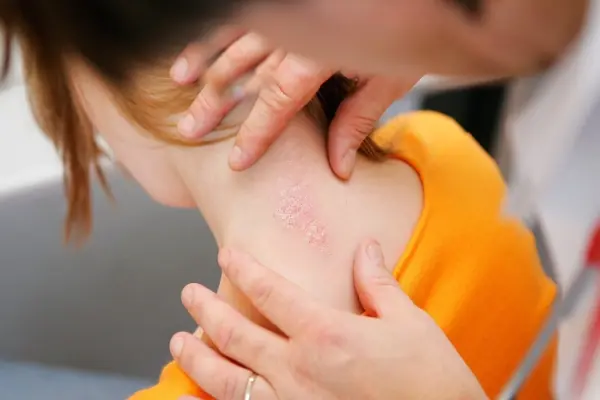
The treatment uses mild preparations that prevent skin drying, microtrauma and itching. It is necessary to abandon all irritants: in food, clothing (preference is given to natural fabrics) - as well as hot baths. Helps against psoriasis:
- moisturizing lotions;
- hormonal drugs (tablets and ointments);
- ultraviolet irradiation;
- herbal medicine for itching (“Suprastin”, “Diphenhydramine”, herbal decoctions);
- immunosuppressants.
Bites
Sometimes small itchy pimples on the body are nothing more than insect bites. The location of the lesion and the appearance of the tubercles will tell you what kind of parasite attacked the person. And he will suggest further actions.
- If the bite appears on an open area of the body, it is small in size and has slight redness - it is a mosquito. Swelling and itching subside on their own within 2-5 days.
- Painful flea bites usually appear on the legs, as well as places where the skin is thin (waist, armpits). They are accompanied by itching, redness and swelling, which, due to scratching, turn into extensive hemorrhages on the skin.
- A bedbug attack goes undetected for several hours. Then bumps and red dots appear on the skin, accompanied by itching.
Having discovered strange swellings on the body and associated them with the presence of blood-sucking animals in the house, it is necessary to immediately find the source of infection and destroy the parasites. First aid for a bite from the above insects is as follows:
- apply a disinfectant to the affected area;
- relieve itching using antiallergic gel (“Psilo-balm”, “Fenistil”) or propolis tincture;
- in case of a severe reaction to the bite, take an antihistamine in tablet form.
You can use traditional methods: treat the itchy area with soapy water, soda water or ammonia. A person should not be allowed to scratch the affected area to avoid bloody wounds and infection.
Scabies
The causative agent of the infection is the scabies mite or itch, which in a short time (in just 15 minutes) penetrates into human skin through direct contact with the patient. The mite digs holes under the skin, laying eggs in them, so the presence of burrows is one of the main signs of scabies.
- on the hands and wrists;
- in the groin;
- on the feet and elbows;
- armpits;
- under the breast;
- in the umbilical region, etc.
The disease is characterized by severe itching, worsening in the evening, and the formation of a papulovesicular rash on the body. When scratching, ulcers appear. However, signs may be minimal if the person is clean, washes regularly, and most parasites are removed from the skin mechanically.
At home, tick burrows can be detected by treating the affected area with iodine. The holes are visualized as brown stripes. But only a doctor can remove the parasite and, if necessary, remove the layer of affected skin in places where it is necessary. Further treatment involves treating the entire body, except the head, with acaricidal ointments (sulfur, Wilkinson's, tar, ethylene glycol, etc.). Secondary infection is eliminated with antiseptic drugs.
Acne mite
Subcutaneous mites can cause acne. The patient is diagnosed with demodicosis. The parasite - the acne gland - is so small that it is impossible to see it; the largest specimens reach 0.5 mm in length. But mites actively reproduce in the sebaceous glands. Frequent places for their localization are the chin, eyebrows, eyelids, but mites can move to other areas of the face and body.
A specialist will tell you in the video presented how to identify and eliminate acne mites on the skin.
Symptoms of the appearance of acne glands:
- redness;
- lumpy skin;
- severe itching;
- swelling and peeling;
- subsequently – the appearance of pimples and blackheads.
It is impossible to diagnose acne mites on your own; you need to consult a dermatologist for advice. He will also prescribe treatment methods: systemic therapy and the use of external agents. Creams and ointments that help against these parasites:
- tar;
- azelaic acid;
- benzyl benzoate;
- Sulfuric ointment;
- Yam ointment
To stop the proliferation of mites under the skin, it is necessary to normalize the metabolism. For these cases, special ointments and complex medications are used, as well as massages. The procedures will help restore the functioning of the skin and blood vessels.
Infection
The rash is a symptom of some infectious diseases, such as herpes, measles, scarlet fever, chickenpox, etc. The peculiarity of such irritations is that they occur in stages and are localized according to the disease.
Infectious diseases are distinguished by the following symptoms:
- increased body temperature;
- swollen lymph nodes;
- symptoms of body intoxication (weakness, headache);
- the appearance of purulent blisters.
The timing of the appearance of the rash is different for different diseases, as well as the place where irritation first appears. Depending on the number of days that have passed since infection, a chronological picture can be traced.
- Rubella attacks on the first day of illness. A pale pink rash appears on the face and then spreads to the body.
- Scarlet fever appears within 1-2 days. A bright red rash moves from the face throughout the torso to the extremities.
- Chickenpox rash is formed 2-3 days after the infection penetrates and begins to spread from the scalp.
- Herpes Depending on the virus, it makes itself felt on days 2-3; small blisters on the skin merge and form open ulcers.
- Measles characterized by the appearance of a rash on days 3-4. The irritation moves in the same way as with scarlet fever - from the head to the body to the arms and legs.
Treatment is selected strictly according to the type of infectious disease. In some cases, the disease goes away on its own. In other cases, it is impossible to do without taking medications.
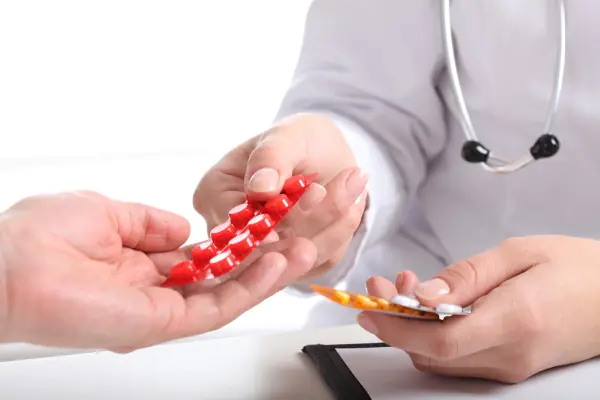
Hormonal disbalance
Excessive acne (including on the body) may indicate a hormonal imbalance. If hormone surges in youth are normal, in adulthood there are several reasons for this problem.
- Increased levels of steroid hormones during menstruation. It goes away on its own.
- Violation of fat metabolism during menopause. Excess fat changes the blood circulation process and overloads blood vessels.
- Diseases of the adrenal glands.
- Gynecological problems are diseases that provoke the production of male hormones.
- Heredity. Predisposition to testosterone production and skin reactions to it.
- Stress, excessive load, during which a large amount of androgen is produced.
The general treatment plan involves taking tests for hormone levels and identifying abnormalities, which can be eliminated with the help of medications and cosmetics. Consultation can be obtained from a gynecologist and endocrinologist.
Prescribed medications are usually taken over a long course, during which the disrupted hormonal levels are normalized. And the external manifestations of the disease are removed with special cosmetics - gels, lotions, foams for washing, which provide deep cleansing of the skin. At the same time, the patient must adhere to proper nutrition.
Poor hygiene
With all the variety of skin parasites and diseases, one of the most common reasons for the appearance of itchy pimples on the body is failure to comply with basic hygiene standards. A body rash occurs when the pores on the skin become filled with oil and dirt. The standard location is the face, back, shoulders, chest, buttocks, armpits, but acne can occur on other parts of the body.
If a person is sure that irritation appeared precisely as a result of contamination, the problem must be eliminated in the following ways:
- Change your diet, give up fatty foods, sweets, alcohol and carbonated drinks.
- Take vitamins comprehensively, especially those containing zinc.
- Use cleansers, but not more than 2-3 times a day, so as not to dry out the skin.
Other causes of itchy body pimples
Everyone is accustomed to believing that acne is the result of skin contamination, improper functioning of the sebaceous glands, or signs of various diseases. But an itchy rash on the body sometimes appears for seemingly unrelated reasons. Acne on the body provokes:
- Weak immunity.
Painful and itchy red pimples on the body are the result of poor functioning of the body. He does not have enough strength to multiply the necessary bacteria and resist infections that get inside or on the skin. Giving up bad habits, normalizing sleep patterns, taking vitamins, etc. will help support your immune system.
- Neurological diseases.
Stress and nervous shock are constant companions of skin rashes. It’s not for nothing that they say: “All diseases come from nerves.” Acne is no exception. During times of stress, the production of male hormones increases, and the liver releases many toxins into the body. Any neurological itching can develop into a rash on the body.
- Poorly selected cosmetics.
Ulcers on the body can occur even when cosmetics are used, but they are poorly chosen. For example, it nourishes oily skin, and dries out dry skin. Sometimes people do not disdain expired goods, and this has a bad effect on skin health.
Prevention
We should never forget about preventing the appearance of any disease, in particular an itchy body rash. In order not to provoke its appearance, you must adhere to the following rules:
- Monitor the condition of your skin. In winter, do not overdry. In summer, use sunscreen.
- Wear properly fitted clothing. Avoid sweating and contact with irritating tissues.
- If the cause of the rash is parasites, it is necessary to disinfect absolutely the entire wardrobe and bedding.
- If the problem is an allergy, continue to follow a diet or avoid contact with irritants.
- Monitor your general health. When there is a suspicion that even a slight skin inflammation is a symptom of a serious illness, you should immediately begin treatment.
Whatever causes itchy irritation on the body, you should not let the development of the disease take its course. The skin will not heal itself. Any unpleasant factor needs to be eliminated, and if you do not start this immediately, you can seriously aggravate the problem.
Pustules do not always itch, and therefore it is important to know why pimples on the face itch. Perhaps there is nothing critical about this. But, nevertheless, itching speaks of certain processes occurring in education. Sometimes it is better to seek professional advice.
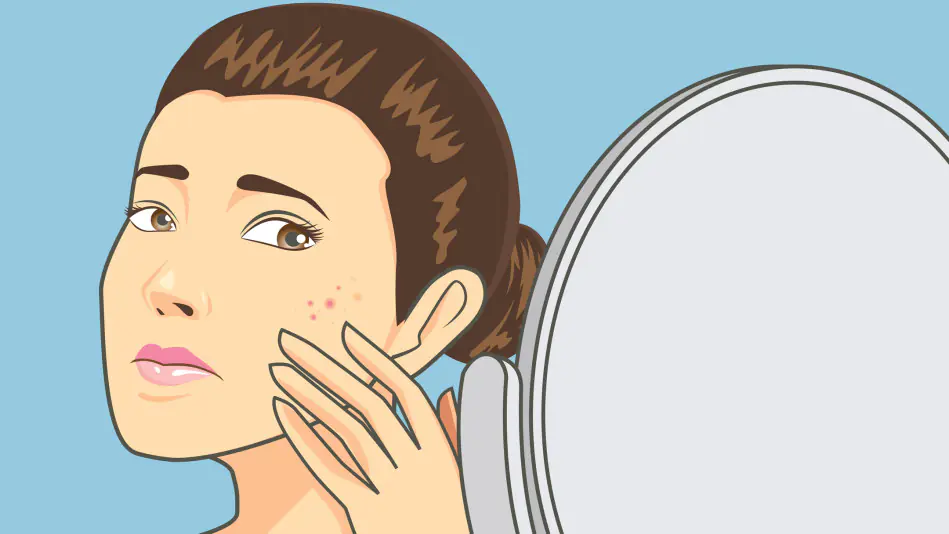
Causes of itching
There are a number of factors that can cause the problem. Among them:
- parasites;
- dryness of the epidermis;
- diabetes;
- infection;
- dermatitis;
- improper skin care;
- stress;
- cancer.
They also itch from too much cosmetics, allergies, tanning, and even bad habits. It is not always possible to determine the cause. Moreover, even a dermatologist will not make a diagnosis until he studies several tests.
Other causes of itching
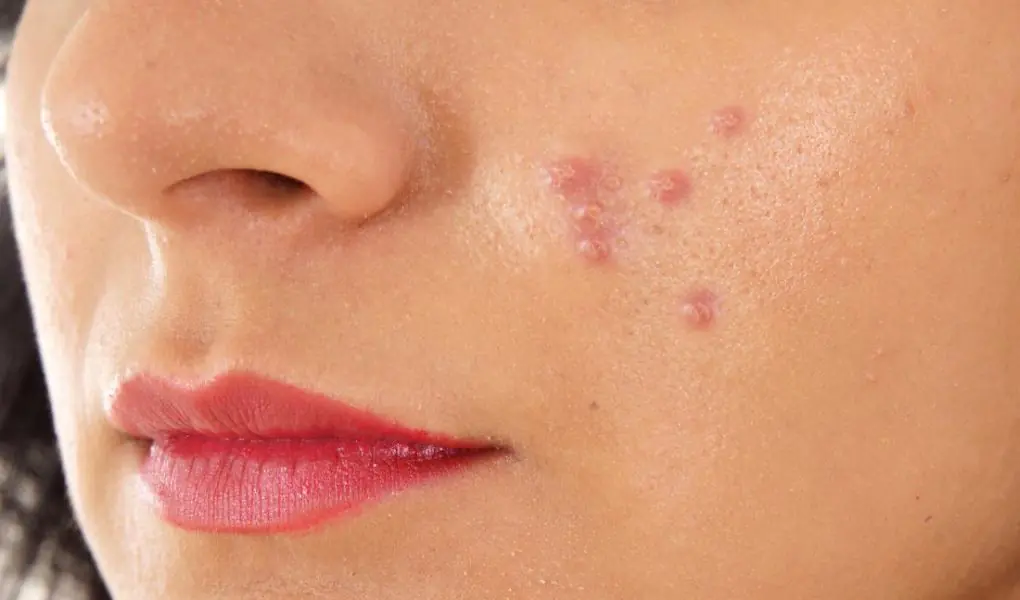
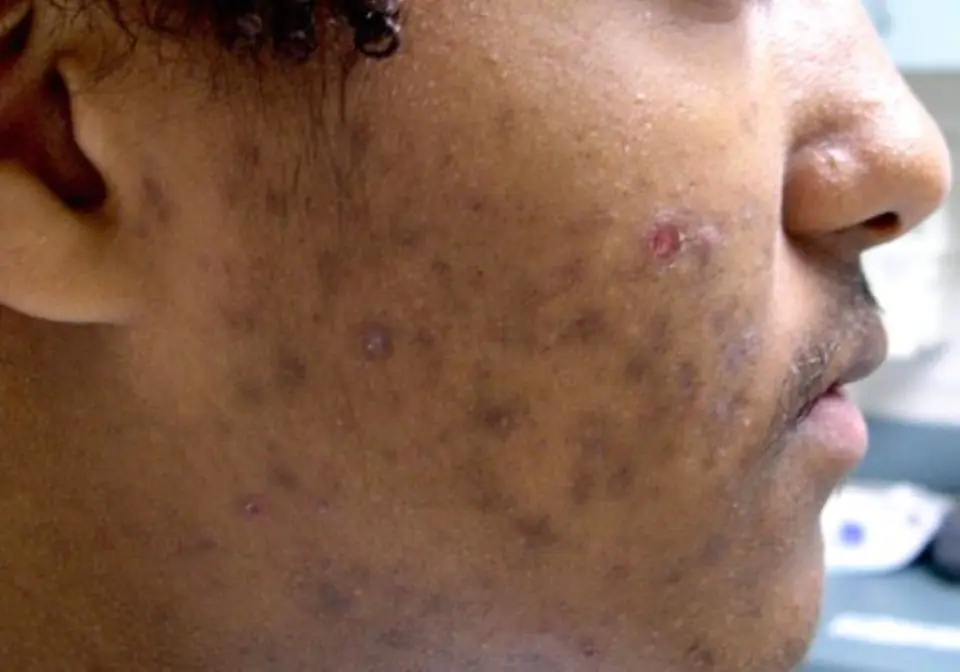
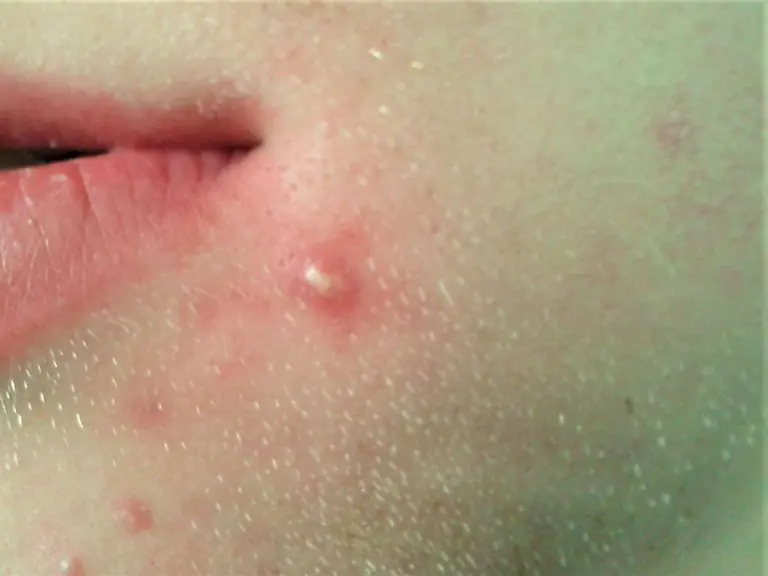
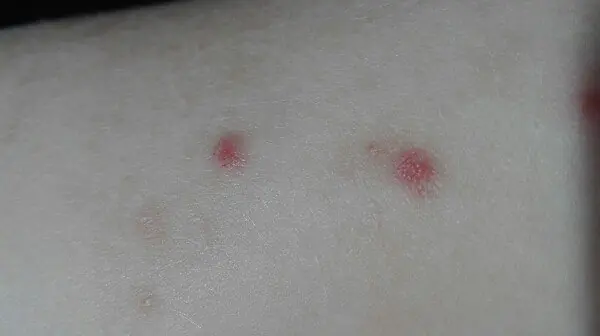
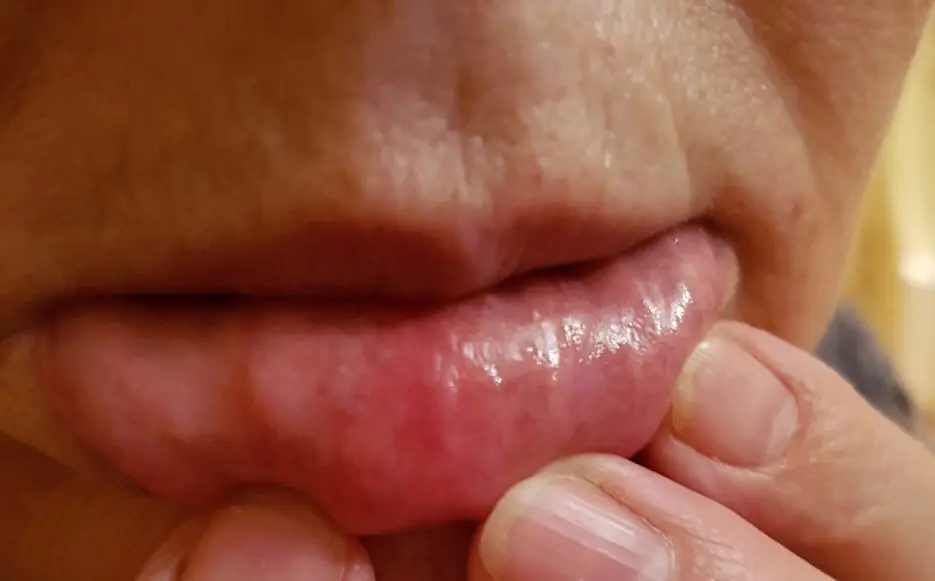
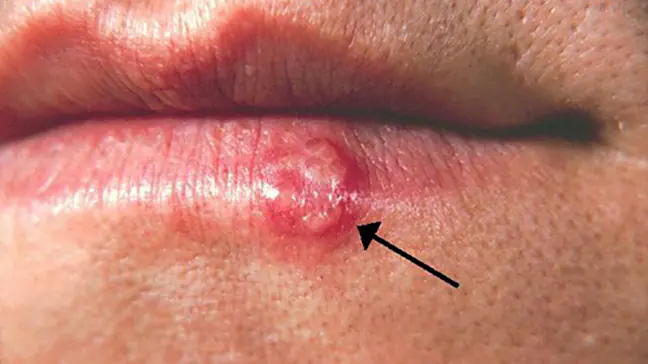
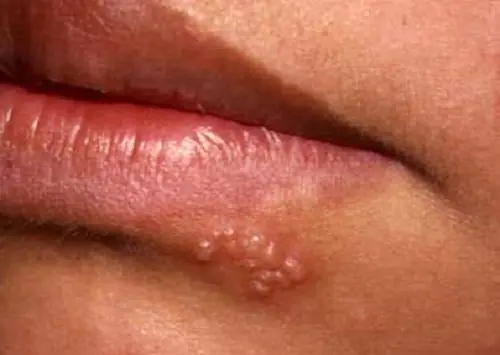
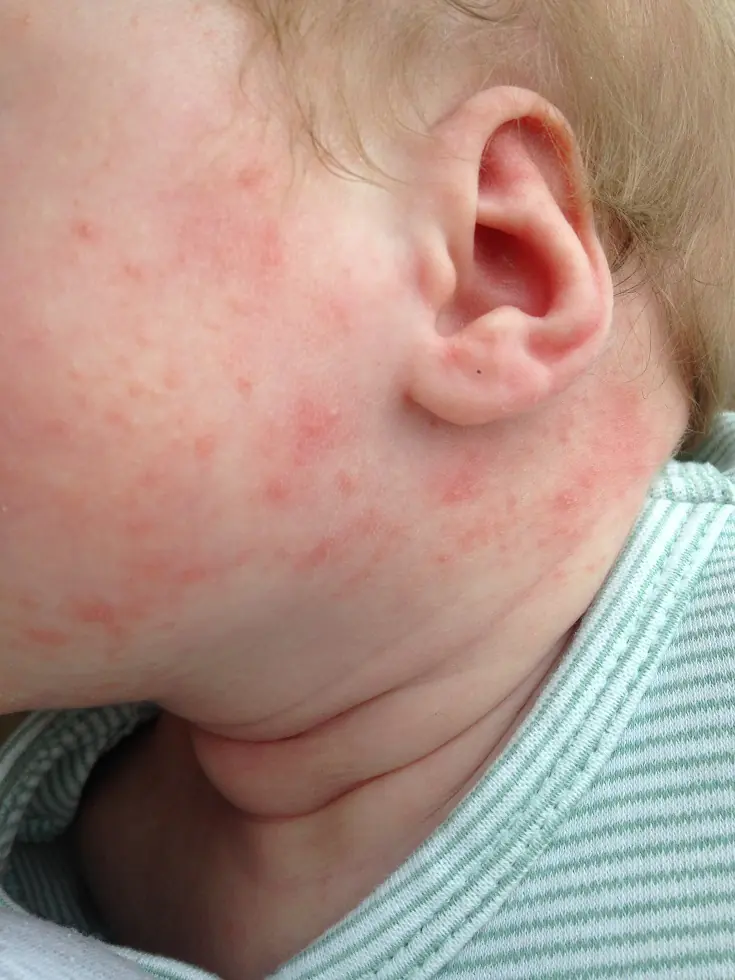

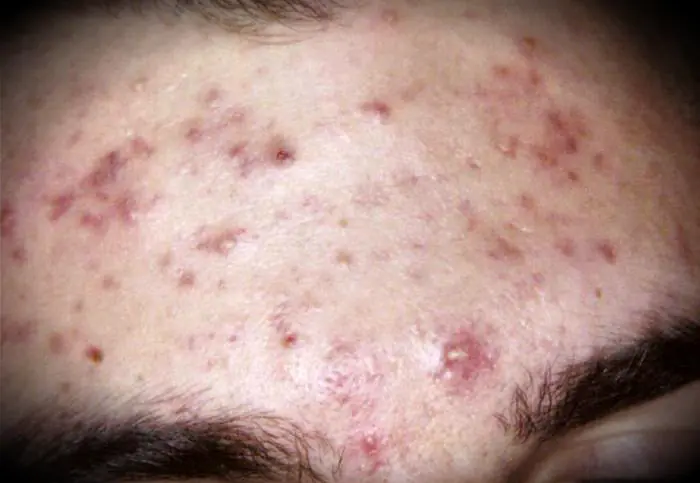
If you cannot see a doctor, carefully analyze the surrounding situation.
Indeed, among the reasons:
- items of clothing;
- dust;
- Food;
- medicines;
- chemicals;
- animals.
The thesis that all diseases are caused by nerves is an exaggeration, but there is some truth in it. Among the causes of diseases, including itchy formations on the face, stress occupies a prominent place. Yes, they may not be the main cause of a particular disease, but they reduce the body’s immunity and undermine health.
Finally, a very common cause is squeezing pimples. It is clear that sometimes you just want to remove an unsightly and unpleasant object on your face, but you can’t do this. With such a careless approach, an infection is introduced into the blood, and this can lead to various consequences, including tragic ones.
Formations that arose for an individual reason deserve special attention. For example, one of the reasons is psoriasis. And in this case, the source of the itchy formations is first treated, after which this trouble will go away by itself.
Treatment
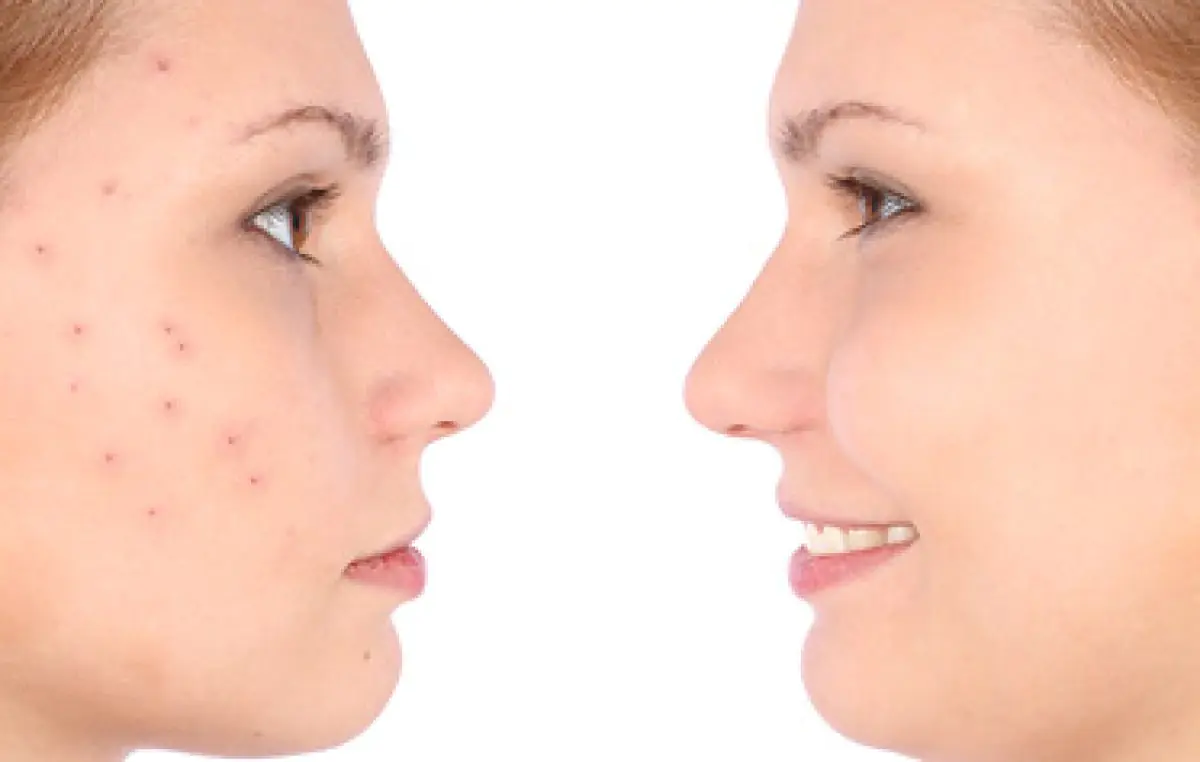
When the skin becomes infected, hypoallergenic agents are used. Among them are those containing calendula, chamomile and aloe. It is clear that the place is first disinfected. Suitable medications are those that will not damage the delicate skin of the face, will not aggravate the formation, but will cope with the infection. It is better to consult a doctor here, since people's skin varies.
Professionals say that stress also causes itching. Moreover, such situations are not uncommon. As a treatment, it is recommended to simply calm down, not be nervous, indulge in pleasant thoughts and not touch the skin of your face. Perhaps this will be enough.
Elena Malysheva says: “There are three degrees of acne or pimples.” With the first degree, there are up to 10 problem areas on the face.
In this case, treatment is only external, with drugs:
- reducing sebum;
- against microorganisms;
- removing hyperkeratin.
In the second degree – from 10 to 40 pimples. Treatment is used both externally and internally. External preparations are drugs of the same type, and external preparations: for females - a hormonal contraceptive; for everyone - the antibiotic dopsicycline.
In the third degree - there are more than 40 formations. Treatment is more serious - drugs with akenolic acid derivatives are used. In this case, external treatment is not carried out. The drug Roaccutane is used. The product blocks the release of sebum from the glands, prevents microbes from feeding, and dries out the skin. Use only after doctor's prescription.
How a doctor can help
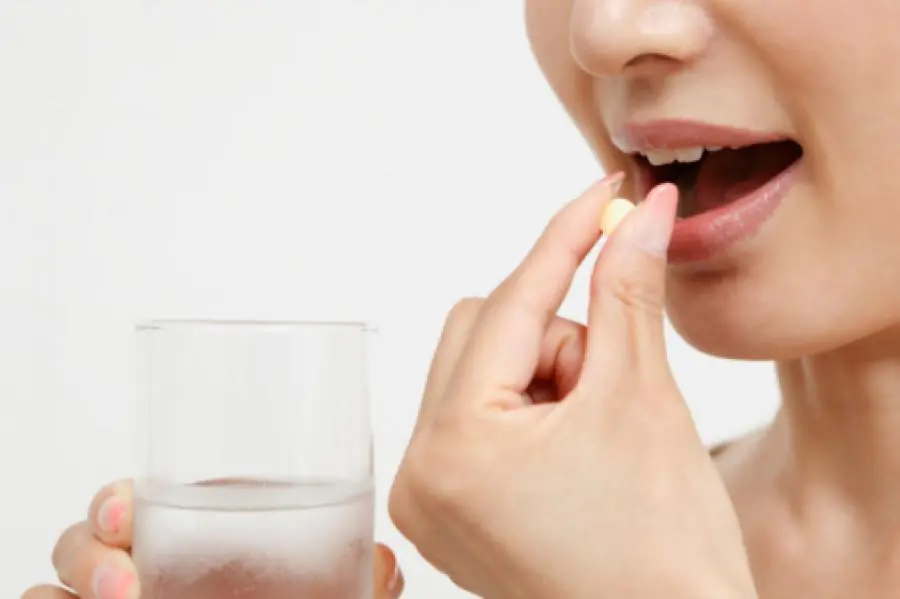
If demodicosis has led to trouble, contact a dermatologist. The latter takes a scraping of the skin, analyzes it and prescribes the treatment that is suitable for a particular situation.
For dermatological diseases, they also turn to a professional rather than self-medicate. Because it is better to prevent the disease faster, and it must be prevented correctly.
- Perhaps the most difficult and confusing case is when formations appear for no apparent reason and itch, preventing a person from living a normal life. After tests, it sometimes turns out that there is no reason as such. You have to order complex tests that will help you understand the problem. In this situation, it is especially important to keep records and record in them the changes that occur not only with the pimple, but with the entire body. Only then will it be clear what to do and how to treat it.
- If a pimple itches after using cosmetics or after using a cream, stop using such products. It is important to understand that the itching will not go away suddenly, but with a healthy lifestyle and the absence of provoking factors, the problem will disappear and is unlikely to bother you again.
- The appearance of small formations in large numbers is a reason to worry, especially if there is itching. It may be an infectious disease that can be transmitted to other people. In such a situation, the face is covered with acne. And if it is completely covered with formations, there is no need to think about it - they immediately go to the doctor.
- Usually, it is not difficult for a doctor to find out why the problem arose and how to deal with it. Therefore, it is impossible to answer the question of what is faster - to treat it yourself or go to the clinic and get a prescription for mash. Rather, it all depends on the seriousness. If the itching is mild, self-treatment is sometimes successful. Otherwise, the best option is a clinic. We should not forget about the consequences of incorrectly counteracting the disease or inaction. Fighting them sometimes takes a lot of time.
Prevention
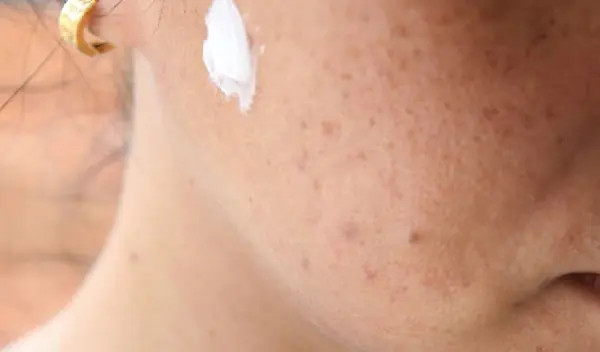
A healthy lifestyle can not only prevent acne itching, but even eliminate it. It is important that you sleep at least eight hours, eat correctly, and vitamins enter the body in the right quantities. An examination by a doctor will also not be superfluous, but it is better to go to clinics healthy and with a strong immune system, so as not to aggravate the condition with new diseases.
A common reason for itchy pimples on the face is a combination of poor hygiene, unhealthy lifestyle, habit of scratching pimples, and lack of stress tolerance.
If you take these factors into account, not only will there be no acne and itching, but also other health problems. It is important to remember how important it is to go to bed on time. The optimal time is ten hours. It's better to wake up at six. “Owls” do not exist, there are only those who go against the biological mechanisms of the body.
Conclusion
Itchy pimples on the face are not uncommon and are usually not a serious problem. However, the discomfort that pustules cause is significant, especially if there are many formations. That is why it is better to quickly get rid of them in a competent way.



